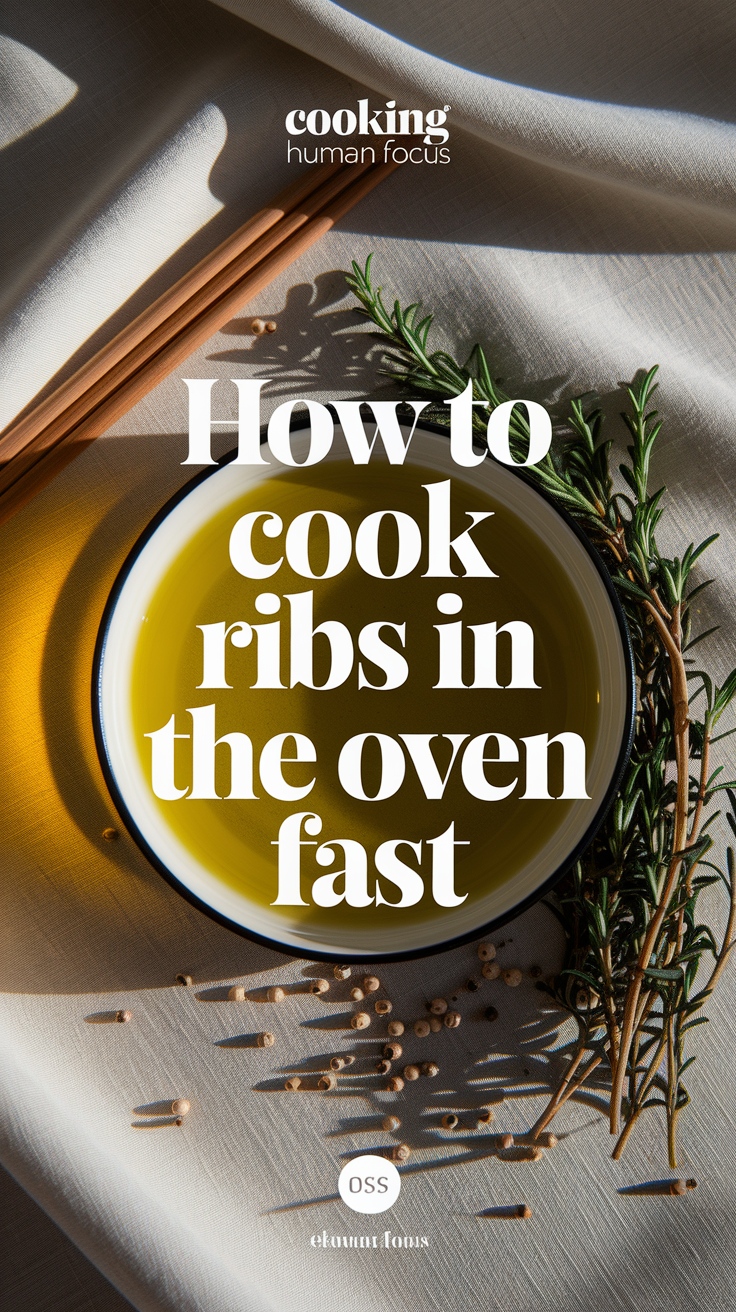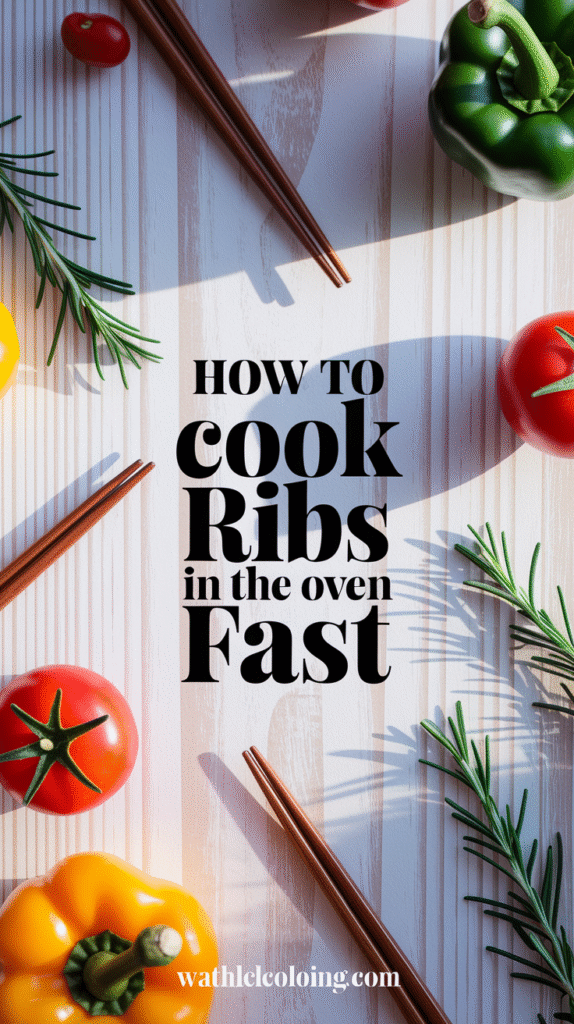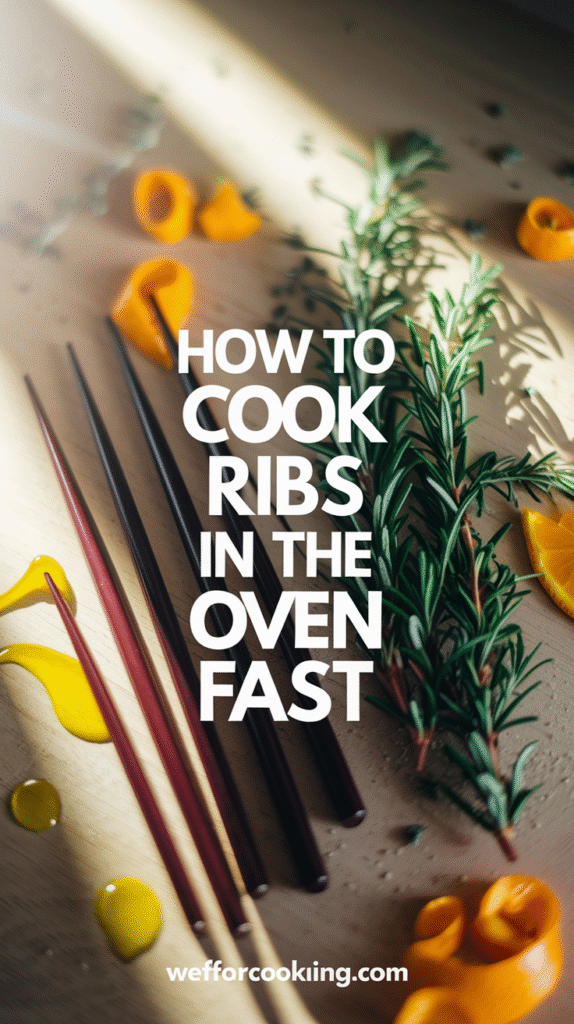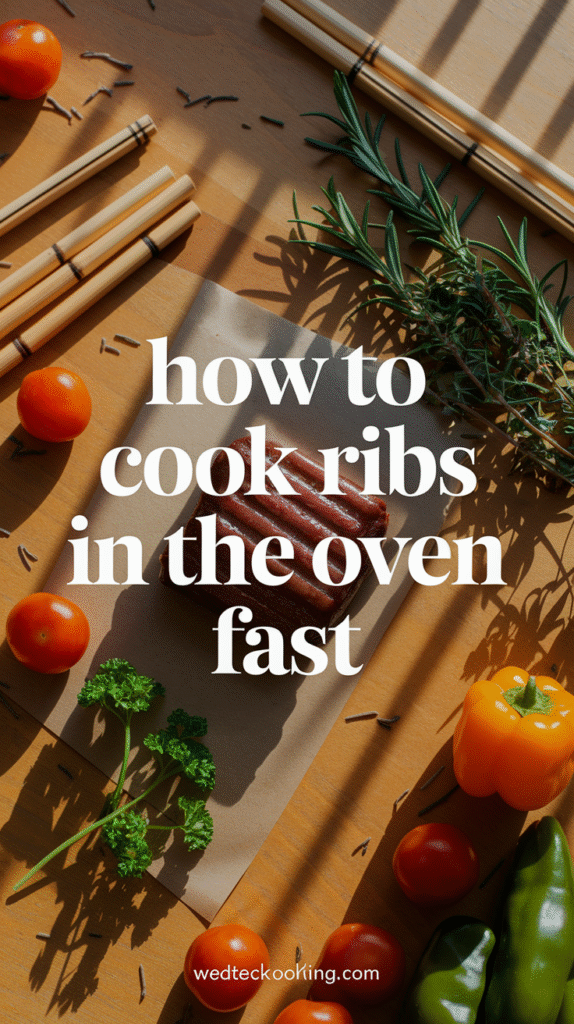Cooking ribs in the oven can be a quick and satisfying way to enjoy this delicious dish without spending hours at the grill. Below are several techniques to speed up the cooking process while ensuring that your ribs remain tender and full of flavor.
Preparing the Ribs
Before you start cooking, preparation is key. Here are the steps to prepare your ribs:
- Choose Your Ribs: Baby back ribs are generally tender and cook faster than spare ribs. Aim for about 2-3 pounds for a family meal.
- Remove the Silver Skin: This tough membrane on the back of the ribs can be peeled off for better flavor absorption and tenderness.
- Season Well: Generously season your ribs with salt, pepper, and your favorite dry rub. Let them sit for at least 30 minutes or refrigerate overnight for deeper flavor.
Quick Cooking Techniques
Here’s how to cook ribs in the oven quickly without sacrificing taste:
1. Use a High Temperature
Preheat your oven to 300°F (150°C). Cooking ribs at a higher temperature helps to tenderize the meat faster. Make sure the ribs are tightly wrapped in foil to retain moisture.
2. The Foil Wrap Method
Using aluminum foil creates a steamy environment that helps to cook the ribs rapidly. Follow these steps:
- Wrap your seasoned ribs tightly in aluminum foil.
- Place them on a baking sheet to catch any drippings.
- Bake for about 2.5 to 3 hours.
This method ensures tender, juicy ribs. For extra flavor, you can add a splash of apple juice or broth inside the foil before sealing.
3. Broil for a Crispy Finish
After baking, you want that perfect crust on your ribs. Switch the oven to broil, and unseal the foil carefully. Broil the ribs for 5-10 minutes, watching closely to avoid burning. This step will caramelize any sauces you added to the ribs.
4. Use a Pressure Cooker
If you need to save even more time, consider using a pressure cooker or an Instant Pot:
- Season the ribs and place them in the pressure cooker with a cup of liquid (like broth or BBQ sauce).
- Cook on high pressure for about 25-30 minutes.
- Let the pressure release naturally for 10 minutes before finishing in the oven under the broiler for a crispy texture.
Flavoring Options
Enhancing the flavor of your ribs is important. Here are some popular choices:
| Flavor Option | Description |
|---|---|
| BBQ Sauce | Traditional sweet and smoky flavor that caramelizes well under high heat. |
| Dry Rubs | A mix of spices like paprika, garlic powder, and cayenne to add depth to the meat. |
| Marinades | Soak ribs in mixtures of vinegar, oil, and seasonings to infuse flavor and tenderness. |
Final Touches
After you’ve cooked your ribs, let them rest for at least 10 minutes. This allows the juices to redistribute throughout the meat, making each bite more flavorful. Before serving, brush on more BBQ sauce if desired for that extra glaze.
With these quick techniques, you’ll find that cooking ribs in the oven can be both efficient and delicious. For more tips on enhancing your cooking skills, visit Serious Eats and Food Network.
Enjoy your quick and easy homemade ribs, perfect for a weeknight dinner or your next gathering!
Essential Seasoning Tips for Flavorful Ribs
Cooking ribs is an art that requires both technique and flavor. Using the right seasonings is essential to elevate your ribs into a delicious and memorable dish. Whether you prefer baby back ribs, spare ribs, or St. Louis-style ribs, the seasoning is key to making them flavorful and mouth-watering.
Choosing the Right Base Seasoning
The first step in any successful rib recipe is choosing a base seasoning. A good rub can make all the difference by enhancing the meat’s natural flavors. Common base ingredients include:
- Salt: Essential for enhancing taste. It draws moisture out from the meat and creates a brine that infuses flavor.
- Pepper: Adds a spice kick without overwhelming the taste.
- Garlic Powder: Offers a deep, aromatic flavor that pairs well with pork.
- Onion Powder: Complements garlic and adds depth.
Sweetness Balance
A sweet element brings out the savory flavors of the ribs. It helps caramelize during cooking and adds a nice glaze. The following ingredients can create a balanced sweetness:
- Brown Sugar: Provides molasses flavor with a rich sweetness.
- Honey or Maple Syrup: Can be added for a sticky glaze.
- Fruit Juices: Adding apple juice or pineapple juice can enhance sweetness while keeping the meat moist.
Spice It Up
Adding spices for that perfect bite is crucial. You can adjust the heat level to your preference. Here are some popular spicy ingredients:
- Cayenne Pepper: For a hot kick, start with a small amount and adjust to your liking.
- Chili Powder: Adds both heat and a rich color to the dish.
- Smoked Paprika: Provides a smoky flavor that mimics traditional barbecue cooking over charcoal.
- Cumin: Gives ribs an earthy depth; use sparingly.
Herbs for Freshness
Herbs can introduce freshness and elevate your rib dish. Consider incorporating:
- Thyme: A classic herb often used with pork that adds an earthy flavor.
- Oregano: Provides a robust Mediterranean taste.
- Rosemary: Strong flavor; use in moderation to prevent it from overpowering the dish.
Creating Your Perfect Rub
To make your seasoning mix into a delicious rub, follow these simple steps:
- Mix the Ingredients: Combine your chosen herbs, spices, and sweeteners in a bowl.
- Massage the Rub: Generously apply the rub to the ribs, ensuring every nook and cranny is covered. You can even let it sit for a few hours or overnight in the fridge for deeper flavor penetration.
- Cooking Method Matters: Whether you’re grilling, smoking, or baking your ribs in the oven, the seasoning will deepen during cooking.
Experimentation is Key
Don’t hesitate to experiment with different combinations. Add other spices or ingredients like mustard or soy sauce to enhance complexity. Remember to taste as you create your rub to ensure it meets your flavor preferences. For more diverse seasoning ideas, you can visit Food Network or Serious Eats.
Storing Your Seasoning Mix
Once you make your perfect rib rub, store any leftover mix in an airtight container. Keep it in a cool and dark place to preserve flavor. You can use this mix for various meats beyond ribs, making it a versatile addition to your seasoning arsenal.
Mastering the art of seasoning ribs is essential for flavoring and enjoying a truly incredible meal. Whether you’re preparing for a summer cookout or a simple family dinner, these seasoning tips will help you create juicy, tasty ribs that everyone will love. Just remember, the right balance of sweet, spicy, and savory elements will transform your cooking and impress your guests.
The Best Cooking Temperatures for Juicy Ribs
Cooking ribs to perfection requires not just the right seasoning but also the right cooking temperature. Achieving juicy and tender ribs in the oven is a balance of time and heat. Understanding the ideal temperatures can elevate your rib game, ensuring a delightful and satisfying meal every time.
The Importance of Correct Cooking Temperatures
When cooking ribs, the temperature is the key player. It influences the texture, tenderness, and flavor. Too high a temperature can lead to tough meat, while too low can leave you with undercooked, chewy ribs. For optimal results, knowing how low and slow or quick and hot methods affect the final product is essential.
Lower and Slower for Tenderness
Cooking ribs at a lower temperature typically allows the meat to break down and become tender while preserving its juiciness. The best range for this method is:
- 225°F to 250°F (107°C to 121°C) – Ideal for traditional slow-cooking
- For the best results, cook the ribs at 225°F for 4-5 hours.
Using this method, the stubborn connective tissues in the ribs, such as collagen, will melt away, yielding tender, delicious meat that falls off the bone. A water pan in the oven can also add moisture, helping prevent drying out.
Fast Cooking Temperatures for Convenience
If you’re short on time, cooking ribs fast can still deliver a satisfying result. Raising your cooking temperature can cut down on cooking time significantly. Recommended higher temperatures include:
- 350°F to 375°F (177°C to 190°C) – Good for quicker meals
- Cooking time is reduced to about 2 to 2.5 hours.
While this method can lead to firm meat, it can be especially effective if you wrap the ribs in foil or butcher paper. This not only reduces cooking time but also retains moisture and flavor during the cooking process.
Finishing Techniques for Best Flavor
Regardless of the initial cooking temperature, finishing your ribs with a glaze or barbecue sauce can elevate the dish significantly. Here’s how to enhance flavor:
- Apply the sauce during the last 30 minutes of cooking at a higher heat (around 400°F/204°C) for a caramelized exterior.
- Broil the ribs for 5-10 minutes after baking to achieve that perfect crust.
Ensure to monitor closely when using high heat to avoid charring the sauce.
Monitoring Internal Temperature
The best way to tell if ribs are thoroughly cooked is to check the internal temperature. You want to aim for:
- For pork ribs, an ideal internal temperature is around 190°F to 203°F (88°C to 95°C).
- Beef ribs benefit from the same range.
Using a meat thermometer is a reliable method to check for doneness. It ensures that the ribs are tender while remaining juicy.
Cooking Tips for Juicy Ribs
Here are some extra tips to help you perfect your rib-cooking technique:
- Always let your ribs rest for about 10-15 minutes after cooking. This helps retain juices for better flavor.
- Experiment with different rubs and marinades to enhance your ribs’ taste.
- Consider wrapping the ribs in foil during cooking to conserve moisture.
By understanding and applying the right cooking temperatures, whether you are going low and slow or turning up the heat for quicker results, you can achieve mouth-watering, juicy ribs every time.
Explore More
For more cooking tips and techniques, visit Serious Eats or The Kitchn for delicious recipes and expert advice.
Common Mistakes to Avoid When Baking Ribs
Baking ribs can be a delightful and rewarding experience, but common mistakes can lead to tough, dry, or bland outcomes. To help you achieve tender, flavorful ribs, here are some pitfalls to avoid.
Skipping the Preparation
One of the biggest mistakes is not properly preparing your ribs. Always start by removing the membrane from the back of the ribs. This thin, tough layer can prevent seasonings from penetrating and lead to chewy meat. Use a paper towel for better grip, and pull it off slowly.
Neglecting to Marinade or Season
Another error is not seasoning your ribs adequately. A dry rub or marinade is crucial for adding flavor. Here are some options for seasoning:
- Dry Rub: Mix brown sugar, paprika, onion powder, garlic powder, salt, and pepper.
- Wet Marinade: Combine soy sauce, honey, mustard, and Worcestershire sauce for a sweet-and-savory taste.
- BBQ Sauce: Apply the sauce during the last 30 minutes of baking for a sticky finish.
Setting the Wrong Temperature
Cooking at incorrect temperatures can make or break your ribs. A common mistake is cooking at too high a temperature, resulting in tough meat. Instead, aim for a lower temperature around 300°F (150°C) to allow the connective tissue to break down, leading to tender ribs.
Not Using Foil Properly
Foil can be your best friend when baking ribs. Failing to wrap them tightly can lead to uneven cooking. Here is a quick guide:
| Method | Description |
|---|---|
| Foil-Wrapped | Wrap ribs tightly in foil for the first part of the cooking process to trap moisture. |
| Unwrapped | Remove the foil during the last hour of cooking to caramelize the sauce. |
Overcooking or Undercooking
Finding the right cooking time is crucial. Overcooking can dry out your ribs, while undercooking can leave them chewy. Typically, ribs take about 2.5 to 3 hours to bake at 300°F (150°C). Use a meat thermometer to check the internal temperature; it should be around 190°F (88°C) for tender meat.
Ignoring Rest Time
Once your ribs are cooked, resist the urge to cut into them immediately. Allow the meat to rest for at least 15 minutes. This gives the juices time to redistribute, ensuring each bite is juicy and flavorful.
Assuming All Ribs are the Same
Different types of ribs vary in cooking times and methods. For instance, baby back ribs are leaner and cook faster than spare ribs, which have more fat and connective tissue. Understand the type of ribs you’re working with to adjust your cooking time and method accordingly.
Not Experimenting with Flavors
Many home cooks get stuck in the habit of using the same BBQ sauce or rub. Experimenting with different flavors can elevate your rib game. Consider adding:
- Smoked Paprika: For a smoky flavor without a smoker.
- Chipotle Peppers: For some heat and rich flavor.
- Apple Cider Vinegar: To add acidity and balance sweetness.
Rushing the Process
Remember that patience is key when baking ribs. Rushing to achieve a quick meal can lead to disappointment. Allow ample time for both cooking and resting. Enjoy the process, and savor the results!
For more tips on cooking different meats, visit Food Network’s Ribs Guide to explore various recipes.
If you’re looking for a great barbecue sauce recipe, check out Serious Eats for an in-depth guide.
Mouthwatering Sauces to Enhance Oven-Cooked Ribs
When it comes to oven-cooked ribs, a delicious sauce can take your meal to a whole new level. Whether you like it sweet, savory, spicy, or tangy, adding the perfect sauce enhances the flavor of the ribs and makes for an unforgettable dining experience. Here are some mouthwatering sauces that will transform your oven-cooked ribs.
Classic BBQ Sauce
A timeless favorite, classic BBQ sauce is a go-to for many rib lovers. Its combination of sweetness and tanginess works perfectly with the rich meat. Here’s how you can make a simple BBQ sauce:
- 1 cup ketchup
- 1/4 cup apple cider vinegar
- 1/4 cup brown sugar
- 1 tablespoon Worcestershire sauce
- 1 teaspoon smoked paprika
Mix all the ingredients in a saucepan over medium heat. Stir until the sugar dissolves, and let the sauce simmer for about 10 minutes. Apply it generously to your ribs during the last 30 minutes of cooking.
Spicy Mustard Sauce
If you enjoy a little kick in your meals, a spicy mustard sauce might be just what you need. This sauce adds a zesty flavor that complements the smokiness of the ribs. Here’s how to whip it up:
- 1/2 cup yellow mustard
- 1/4 cup honey
- 1 tablespoon apple cider vinegar
- 1 teaspoon cayenne pepper
Simply combine all the ingredients in a bowl and whisk until smooth. This sauce can be brushed on the ribs during cooking or served on the side for dipping.
Honey Garlic Glaze
This sauce creates a sweet and savory glaze that makes your ribs shine. The honey caramelizes as the ribs cook, providing an incredible flavor. To make this delightful glaze, use the following:
- 1/3 cup honey
- 1/4 cup soy sauce
- 3 cloves garlic, minced
- 1 teaspoon black pepper
Combine all the ingredients and simmer them for about 5 minutes on low heat. Brush this glaze on your ribs in the last 15 minutes of baking to achieve that perfect finish.
Carolina Vinegar Sauce
For those who appreciate a tangy twist, Carolina vinegar sauce is perfect. This sauce is thinner than most BBQ sauces but packs a flavor punch. Ingredients include:
- 1 cup apple cider vinegar
- 2 tablespoons sugar
- 1 teaspoon salt
- 1 teaspoon red pepper flakes
Mix all the ingredients and let it sit for at least 30 minutes for the flavors to meld. While baking your ribs, use this sauce to baste periodically for an added zing.
Smoky Chipotle Sauce
This sauce is perfect for those who love smoky flavors with a bit of heat. Its bold taste can truly elevate your ribs. Here’s how you can make it:
- 1 cup tomato sauce
- 2 tablespoons adobo sauce (from chipotle peppers)
- 1 tablespoon brown sugar
- 1 teaspoon cumin
Mix these ingredients together in a saucepan and simmer for about 10 minutes. The smoky chipotle flavor will result in an explosion of taste.
Maple Bourbon Sauce
If you want to impress your guests with something unique, consider a maple bourbon sauce. The blend of maple syrup and bourbon gives a sweet, rich flavor. Combine these items:
- 1/2 cup maple syrup
- 1/4 cup bourbon
- 1 tablespoon Dijon mustard
- 1/2 teaspoon garlic powder
Cook these ingredients in a saucepan over medium heat for about 10 minutes, then baste your ribs in the last half hour of cooking.
When choosing a sauce for your oven-cooked ribs, the options are endless! Don’t be afraid to mix and match or even create your own signature sauce. For some inspiration and recipes, check out Food Network or Serious Eats.
Experimenting with these sauces can turn a simple rib dish into a memorable feast. Enjoy your culinary journey with these delicious additives, and may your oven-cooked ribs be the star of your next meal!
Conclusion
Cooking ribs in the oven can be a swift and rewarding experience, allowing you to enjoy tender, juicy meat without spending hours over a grill or smoker. By employing quick techniques like the reverse sear or the foil-wrapping method, you can significantly reduce cooking time while still achieving that fall-off-the-bone tenderness. Pairing these methods with essential seasoning tips ensures your ribs are packed with flavor, enhancing every bite to make your meal unforgettable.
Using the right cooking temperatures is crucial for achieving juicy ribs. Keeping an eye on the heat—not too high and not too low—will help maintain the moisture while allowing the connective tissue to break down. Also, being aware of common mistakes, such as rushing the cooking process or neglecting to rest the meat, can help prevent disappointing results.
To elevate your ribs even further, don’t overlook the impact of mouthwatering sauces. Whether you prefer a tangy barbecue glaze or a spicy rub, the right addition can take your oven-cooked ribs from good to great. Experiment with different sauces and serve them on the side to cater to varying tastes.
By following these tips and techniques, you’ll serve up delicious ribs that will impress family and friends alike, making your kitchen the go-to spot for tasty meals. With just a little practice and some thoughtful preparation, cooking ribs in the oven fast becomes an enjoyable and delectable endeavor. Enjoy your rib-cooking journey!







Leave a Reply